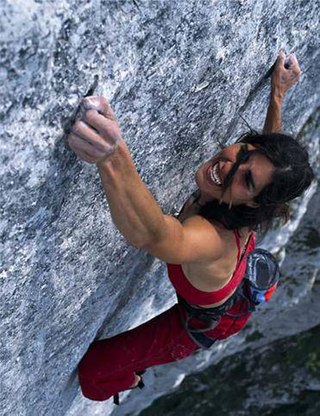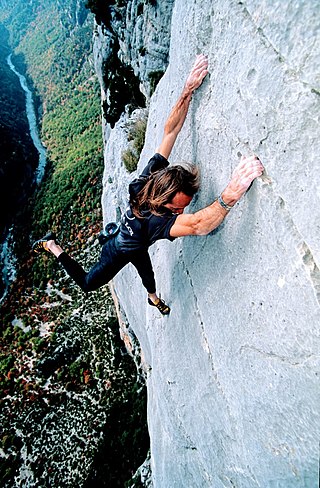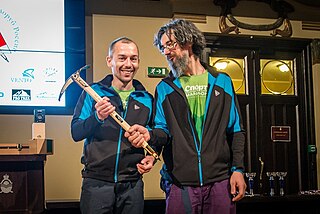
In mountaineering and climbing, a first ascent, is the first successful documented climb to the top of a mountain or the top of a particular climbing route. Early 20th-century mountaineers and climbers focused on reaching the tops of iconic mountains and climbing routes by whatever means possible, often using considerable amounts of aid climbing, and/or with large expedition style support teams that laid "siege" to the climb.

Solo climbing, or soloing, is a style of climbing in which the climber climbs a route alone, without the assistance of a belayer. By its very nature, it presents a higher degree of risk to the climber, and in some cases, is considered extremely high risk. Note that the use of the term "solo climbing" is generally separate from the action of bouldering, which is itself a form of solo climbing, but with less serious consequences in the case of a fall. The most dangerous form of solo climbing is free solo climbing, which means both climbing alone and without any form of climbing protection.

The Trango Towers are a family of rock towers situated in the Gilgit-Baltistan region, in the northern part of Pakistan. The Towers have some of the world's largest cliffs and offer some of the most challenging big wall climbing opportunities. Each year, climbers from around the world embark on expeditions to the Karakoram region to climb these granite faces. The Trango Towers are situated to the north of the Baltoro Glacier and are part of the Baltoro Muztagh, which is a sub-range within the Karakoram mountain range. The highest point within the group is the summit of Great Trango Tower at 6,286 m (20,623 ft), the east face of which features the world's greatest nearly vertical drop.

Josune Bereziartu, also known as Josune Bereciartu Urruzola, is a Basque rock climber. For a decade starting in the late 1990s, she was considered the strongest female sport climber in the world and is regarded as one of the most important female rock climbers in history.

Free solo climbing, or free soloing, is a form of rock climbing where the climbers climb solo without ropes or other protective equipment, using only their climbing shoes and their climbing chalk. Free soloing is the most dangerous form of climbing, and, unlike bouldering, free soloists climb above safe heights, where a fall can be fatal. Though many climbers have free soloed climbing grades they are very comfortable on, only a tiny group free solo regularly, and at grades closer to the limit of their abilities.

Walter Bonatti was an Italian mountaineer, alpinist, explorer and journalist. He was noted for many climbing achievements, including a solo climb of a new alpine climbing route on the south-west pillar of the Aiguille du Dru in August 1955, the first ascent of Gasherbrum IV in 1958, and, in 1965, the first solo climb in winter of the North face of the Matterhorn on the mountain's centenary year of its first ascent. Immediately after his solo climb on the Matterhorn, Bonatti announced his retirement from professional climbing at the age of 35, and after 17 years of climbing activity. He authored many mountaineering books and spent the remainder of his career travelling off the beaten track as a reporter for the Italian magazine Epoca. He died on 13 September 2011 of pancreatic cancer in Rome aged 81, and was survived by his life partner, the actress Rossana Podestà.

The six great north faces of the Alps are a group of vertical faces in the Swiss, French, and Italian Alps known in mountaineering for their difficulty, danger, and great height. The "Trilogy" is the three hardest of these north faces, being the Eiger, the Grandes Jorasses, and the Matterhorn.

The Piolets d'Or is an annual mountaineering and alpine climbing award organized by the Groupe de Haute Montagne (GHM), and previously with co-founder Montagnes Magazine, since its founding in 1992. Golden ice axes are presented to the annual winners at a weekend awards festival based on their achievements in the previous year. It is considered mountaineering's highest honor and is referred to as the "Oscars of mountaineering".

Rope-solo climbing or rope-soloing is a form of solo climbing, but unlike with free solo climbing, which is also performed alone and with no climbing protection whatsoever, the rope-solo climber uses a mechanical self-belay device and rope system, which enables them to use the standard climbing protection to protect themselves in the event of a fall.

In the history of rock climbing, the three main sub-disciplines—bouldering, single-pitch climbing, and big wall climbing—can trace their origins to late 19th-century Europe. Bouldering started in Fontainebleau, and was advanced by Pierre Allain in the 1930s, and John Gill in the 1950s. Big wall climbing started in the Dolomites, and was spread across the Alps in the 1930s by climbers such as Emilio Comici and Riccardo Cassin, and in the 1950s by Walter Bonatti, before reaching Yosemite where it was led in the 1950s to 1970s by climbers such as Royal Robbins. Single-pitch climbing started pre-1900 in both the Lake District and in Saxony, and by the late-1970s had spread widely with climbers such as Ron Fawcett (Britain), Bernd Arnold (Germany), Patrick Berhault (France), Ron Kauk and John Bachar (USA).
Wojciech Kurtyka is a Polish mountaineer and rock climber, one of the pioneers of the alpine style of climbing the biggest walls in the Greater Ranges. He lived in Wrocław up to 1974 when he moved to Kraków. He graduated as engineer in electronics. In 1985 he climbed the "Shining Wall," the west face of Gasherbrum IV, which Climbing magazine declared to be the greatest achievement of mountaineering in the twentieth century. In 2016, he received the Piolet d'Or for lifetime achievement in mountaineering.

Big wall climbing is a form of rock climbing that takes place on long multi-pitch routes that normally require a full day, if not several days, to ascend. In addition, big wall routes are typically sustained and exposed, where the climbers remain suspended from the rock face, even sleeping hanging from the face, with limited options to sit down or escape unless they abseil back down the whole route. It is therefore a physically and mentally demanding form of climbing.

Ueli Steck was a Swiss rock climber and alpinist. He was the first to climb Annapurna solo via its South Face, and set speed records on the North Face trilogy in the Alps. He won two Piolet d'Or awards, in 2009 and 2014. Having previously summitted Mount Everest, Steck died on 30 April 2017, after a fall during an acclimatizing climb for an attempt on the Hornbein route on the West Ridge of Everest without supplemental oxygen.

Sasha DiGiulian is a professional rock climber who specializes in competition climbing, sport climbing and bouldering. She won the gold medal at the 2011 International Federation of Sport Climbing World Championships in Arco, Italy, for Female Overall, placed Silver in Bouldering and Bronze in Duel. Sasha won multi-year PanAmerican championships and is a three-time US National Champion.

Alpine climbing is a type of mountaineering that involves using any of a broad range of advanced climbing skills, including rock climbing, ice climbing, and/or mixed climbing, to summit typically large routes in an alpine environment. While alpine climbing began in the European Alps, it is used to refer to climbing in any remote mountainous area, including in the Himalayas and in Patagonia. The derived term alpine style refers to the fashion of alpine climbing to be in small lightly-equipped teams who carry all of their own equipment, and do all of the climbing.

Ines Papert is a German alpine climber, and a world champion ice and mixed climber best known for her competition ice climbing awards and difficult alpine ascents. She has made a number of first ascents and has broken difficulty grade milestones for female climbers.
Brette Harrington is an American professional rock climber and alpinist based in Lake Tahoe, California and British Columbia, Canada. She was featured in the 2021 film The Alpinist alongside her late partner, Marc-André Leclerc. She is best known for the first free solo of the 760 meter (2,500-foot) Chiaro di Luna (5.11a) in Patagonia, for her development of new alpine climbing routes, and as the star of Brette, a Reel Rock Film Tour short film.
The recorded history of climbing of the Eiger mountain in Switzerland starts in the 1800s. It is split between the pre-north face era, when the main summits and easier ridges and faces were climbed, and the post-north face era, when it became one of the greatest prizes in mountaineering. At least sixty-four climbers have died while attempting the ascent.

Barbara "Babsi" Zangerl is an Austrian rock climber who is widely considered as one of the best all-round female climbers in the world. At various stages in her career, she has climbed at, or just below, the highest climbing grades achieved by a female in every major rock climbing discipline, including bouldering, traditional climbing, sport climbing, multi-pitch climbing and big wall climbing.
















